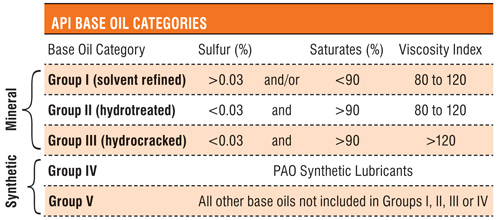How Base Oil Affects Lubricant Performance
TestOil’s oil analysts know that a lubricant’s base stock can have a significant impact on performance. These base stocks range from minimally refined mineral oil to very sophisticated PAOs, some further enhanced with leading-edge catalyst technology. Starting with the fundamentals, there are five basic base stock categories:[1]

- Group I base stocks are the least refined. They are usually a mix of different hydrocarbon chains, which is about all they have in common. These base stocks are not best for applications requiring high performance.
- Group II base stocks are common in off-the-shelf mineral-based motor oils. In terms of volatility, oxidative stability and flash/fire points they are adequate. Where they struggle is extreme pressure, cold start viscosity and pour point performance.
- Group III base stocks are the most highly refined of all mineral base stock groups. Group III base stocks generally perform well and are very stable. Lubricants that result from these base stocks are synthetic or semi-synthetic.
- Group IV base stocks are PAOs (polyalphaolefins). They are synthetic and chemically engineered with uniform molecular chains and very stable chemical compositions. These base stocks are becoming more and more common in synthetic and synthetic-blend fluids in industrial applications.
- Group V encompasses just about everything that is not included in the other four base stock groups. They are rarely used as base stock by themselves, but may be used in small quantities as secondary base stocks to impart certain custom properties. They are also used as base oils for additives.
Most lubricants are a blend of at least one basestock and additives. The chemical composition (mostly saturates and sulfur) of these basestocks, along with any additives determines how lubricants perform. Lubricant properties affected by base stock include:[1]
- Viscometrics
- SAE viscosity grade
- Pour point and low temperature fluidity
- Fuel economy
- Wear Protection
- Oxidation
- Viscosity increase
- Acid formation (leading to corrosion)
- Deposit control
- Dispersancy and solvency
- Soot Control
- Viscosity increase and filter plugging
- Sludge
- Deposit control
- Foaming and air entrainment
- Volatility (evaporation)
- Oil consumption and Flash Point
Regardless of the lubricant’s properties, a comprehensive oil analysis program is critical to optimizing lubricant performance. Working with a lab, like TestOil, that knows the unique properties of base stocks– their performance limitations and advantages–will ensure a more accurate picture of lubricant health.
[1] From Infineum “Lubricant Base Stocks” May be available at: https://www.infineuminsight.com/media/1814/3-lubricant-base-stocks-na.pdf
[1] Base stock category information courtesy of The American Petroleum Institute and TLT Magazine.

